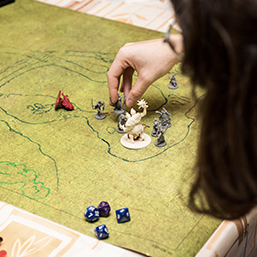
Dungeons & Dragons (D&D) is a venerable pen-and-paper roleplaying game using dice and miniatures, first published in 1974. Although it was originally marketed for college-aged players, it’s experiencing a massive cultural resurgence and is becoming popular with younger and younger adventurers. In Dungeons & Dragons, adventurers often explore dungeons and defeat monsters in a cooperative setting, working together to solve puzzles and discover secrets. The basic game is freely available and can be adapted to suit any group of players, ages, and interest levels, although the dice elements mean it’s often best suited to players ten or 11 and up.
Most games have:
Required materials:
Optional materials:
Why is it gaining popularity?
D&D is gaining in popularity, partially because of the nostalgia factor from adults who grew up playing, but also thanks in part to the success of the movie Dungeons & Dragons: Honor Among Thieves, which came out last year and is now available to stream on Netflix. The game is also gaining popularity thanks to the popularity of online streaming of games, both with celebrity players and average podcasters.
Another factor is that while there are many D&D materials and accessories that players can purchase, the base game is actually freely available. There are many free campaigns available, or players can create their own campaigns from free materials. Many public library systems and social groups like the YMCA across North America offer D&D programming and carry source books and adventures on their shelves. The Calgary Public Library offers a Dungeons & Dragons starter kit at select locations, and sometimes offers D&D programs.
Getting started
The easiest way to get started with Dungeons & Dragons is to find a group offering a starter session. These sessions generally have an experienced Dungeon Master walk first-time players through the rules and guidelines of the game.
Once you understand the basics, you can find many free campaigns either from the official D&D publisher, published campaigns at your local library branch, or from the many player-created campaigns that exist. When using player-created campaigns, make sure to check for age rating and content.
Our Dungeons & Dragons Birthday
As an example of how engaging D&D can be for kids, we hosted an 11th birthday party that was centered around the freely available LEGO D&D campaign. This campaign was created to accompany a specific LEGO set, but can be played without purchasing the set and comes with pre-created characters and challenges.
We had the guests (between nine and 11 years old) select their characters from the pre-set campaign based on the descriptions of what the characters were able to do, and to make it easier for first-time players, we had pre-printed cards of the weapons, armor, magic spells, and supplies each character carries. This helped the players to be able to understand what actions were available to them. Each guest then named their character, and we had our first activity where guests used LEGO minifigure pieces we had gathered to build what they wanted their character to look like.
Our Dungeon Master then went through the basic rules of the game, including explaining vocabulary the guests didn’t know, identifying the various dice, etc. The guests then played through the adventure under the guidance of the Dungeon Master. They came up with creative and funny solutions to the situations they encountered. We let the guests set the pace, as well as allowing them to say when they needed a break along the way, which we used as opportunities to eat snacks or move around and stretch.
We provided standard birthday party snacks and drinks, as well as a themed cake. Each of the guests received a set of polyhedral dice to play the campaign and to take home as part of their goody bags, alongside some more standard goody bag treats.
The guests were engaged and interested for four hours creating a story, solving problems, reading, writing, and even doing simple math equations to complete the campaign. All the guests were interested in playing again, and only one had played the game prior to the party.
Why is it good for kids?
Dungeons & Dragons has all the appeal of role-playing video games, while being an offline, social experience that promotes literacy, numeracy, and creative thinking.
When playing D&D, players are confronted with various puzzles, challenges, and obstacles, and they can use creative logic to solve them in any number of ways. While combat is an aspect of D&D, younger players often come up with creative solutions that circumvent violence. Players need to work with one another to come up with solutions to the problems. To execute these solutions the Dungeon Master will require ‘skill checks,’ which is simply the player rolling one or a combination of dice and doing simple addition to determine success. The vocabulary of the game can be challenging as it is set in a fantasy realm, but it can also be simplified or used to expose players to a variety of languages to improve literacy skills.
Because the game itself is so adaptable, the difficulty can be changed to accommodate the needs and interests of the players, which helps to make the game inclusive. As a cooperative game, it helps give children practice at compromise and working as a group.
This can also be a great activity to enjoy with the whole family – why not add a regular D&D night to your routine? A family that slays dragons together, stays together!
Trista is a stay-at-home mom and loves to share her discoveries about how to make life work for families of all kinds.
See our related articles:
Calgary’s Child Magazine © 2024 Calgary’s Child